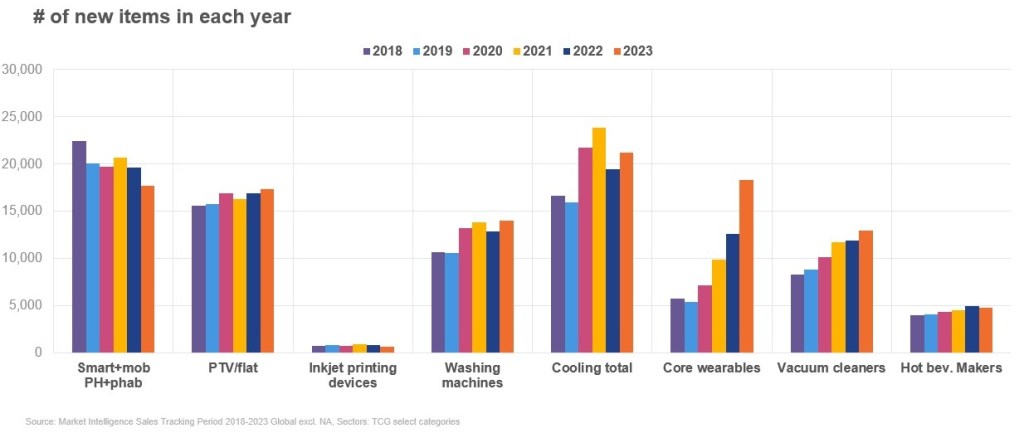Driving Consistent Volume Growth in the Tech and Consumer Goods Sector
The technical consumer goods (TCG) market has shown resilience post-pandemic, with a global sales value of $395 billion for the first half of 2024. While the sector is seeing steady recovery, budget reductions, market uncertainty, and retailer pressure continue to challenge innovation. Despite this, consumer demand for affordability and value has helped keep volume growth stable, even as the sales value dips in certain sectors.

The demand for consumer goods varies significantly across sectors, influenced by factors such as replacement cycles, energy efficiency regulations, market saturation and climate change. Air conditioners are a good example of increased demand due to climate change. Meanwhile, sectors such as mobile computing and televisions are experiencing slower growth, driven by market saturation and replacement cycles.
To stay competitive, companies are focusing on product innovations that prioritize affordability, performance, and sustainability. By introducing energy-efficient, feature-rich products, brands can cater to the evolving needs of consumers who are looking for both value and cutting-edge functionality.


The key to success in innovation is aligning new product offerings with what consumers truly want: solutions that improve health, wellbeing, and simplify complex tasks
Here are 3 essential takeaways about Innovation in the retail market to keep an eye on:
1. Consumer Preferences: Personalization is Key
Consumers are prioritizing durability, quality, convenience, and eco-friendliness in their purchasing decisions. Personalization has become a powerful driver, emphasizing the need for retailers to deliver a seamless, engaging customer journey.
Consumers are no longer satisfied with one-size-fits-all offerings; they expect personalized product recommendations, tailored promotions, and individualized customer service both before and after a purchase.
This trend extends across both online and offline channels, as direct-to-consumer (DTC) models gain popularity for offering bespoke experiences. Retailers who successfully leverage data-driven insights to deliver personalized experiences stand to build stronger customer loyalty, improve engagement, and ultimately boost sales.
2. Social Commerce and Direct-to-Consumer Trends
Social commerce is a rapidly growing opportunity, particularly through platforms like TikTok Shop, which is projected to reach €3.7 billion in potential annual spend across Western Europe.
Consumers, especially younger generations, are increasingly interacting with brands on social platforms and expect a seamless shopping experience.

Direct-to-consumer (DTC) models are also gaining traction, offering tailored experiences that traditional retail channels may struggle to match.
3. Retail Media and the Future of Advertising
Retail media has emerged as a dominant force in advertising, now accounting for 20% of total online ad spending. Brands and retailers alike are exploring innovative ways to merge digital and physical retail experiences, creating opportunities for more personalized and targeted marketing campaigns. As e-commerce continues to grow, retailers must find a balance between customer-centric strategies and commercial goals.
As more brands flock to these platforms, competition for ad space is increasing, driving up the cost of advertising. Brands are therefore seeking accountability from retailers about the effectiveness of their ad spend and how that translates into product sales. Eventually, we’ll see more and more retailers developing a media arm or collaborating closely with media partners to adopt differentiated business models. This approach will allow them to stand out in their advertising offerings compared to competing retailers.
Final Takeaways: Thriving in a Dynamic Retail Landscape
In today’s fast-paced market, innovation and personalization are at the forefront of driving consumer engagement and sales than ever. While challenges such as budget reductions and market uncertainty remain, consumer demand for affordable, high-performing, and eco-friendly products continues to shape purchasing decisions. By focusing on value-driven and closely aligning with consumer priorities, retailers can ensure their relevance and resilience in the future of retail.
INNOVATION will be key to growth, just as it has been in the last 100 years.
This blog captures the high-level insights from Michael McLaughlin, President of Retail at NielsenIQ keynote session at the IFA conference, Berlin 2024.

Looking to unlock the full potential of your data?
Chances are, your competitors are benefiting from our Retail Data Partners Program. Now it’s your turn. Whether you’re looking to improve your analytics, automate processes, or tap into new data sources, the NIQ Partner Program has the dynamic expertise and resources you need.


![Understanding your audience: The power of segmentation in retail [podcast]](https://nielseniq.com/wp-content/uploads/sites/4/2025/07/Podcast-Understanding_your_audience-The_power_of_segmentation_in_retail-mirrored.jpg?w=1024)
